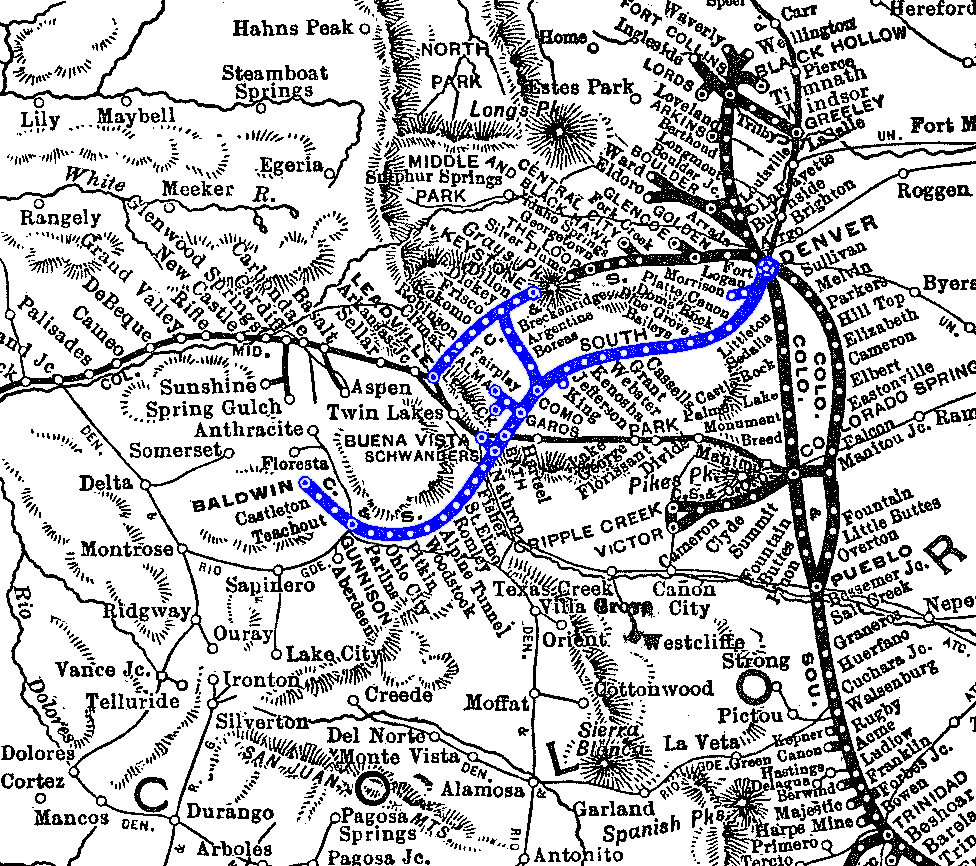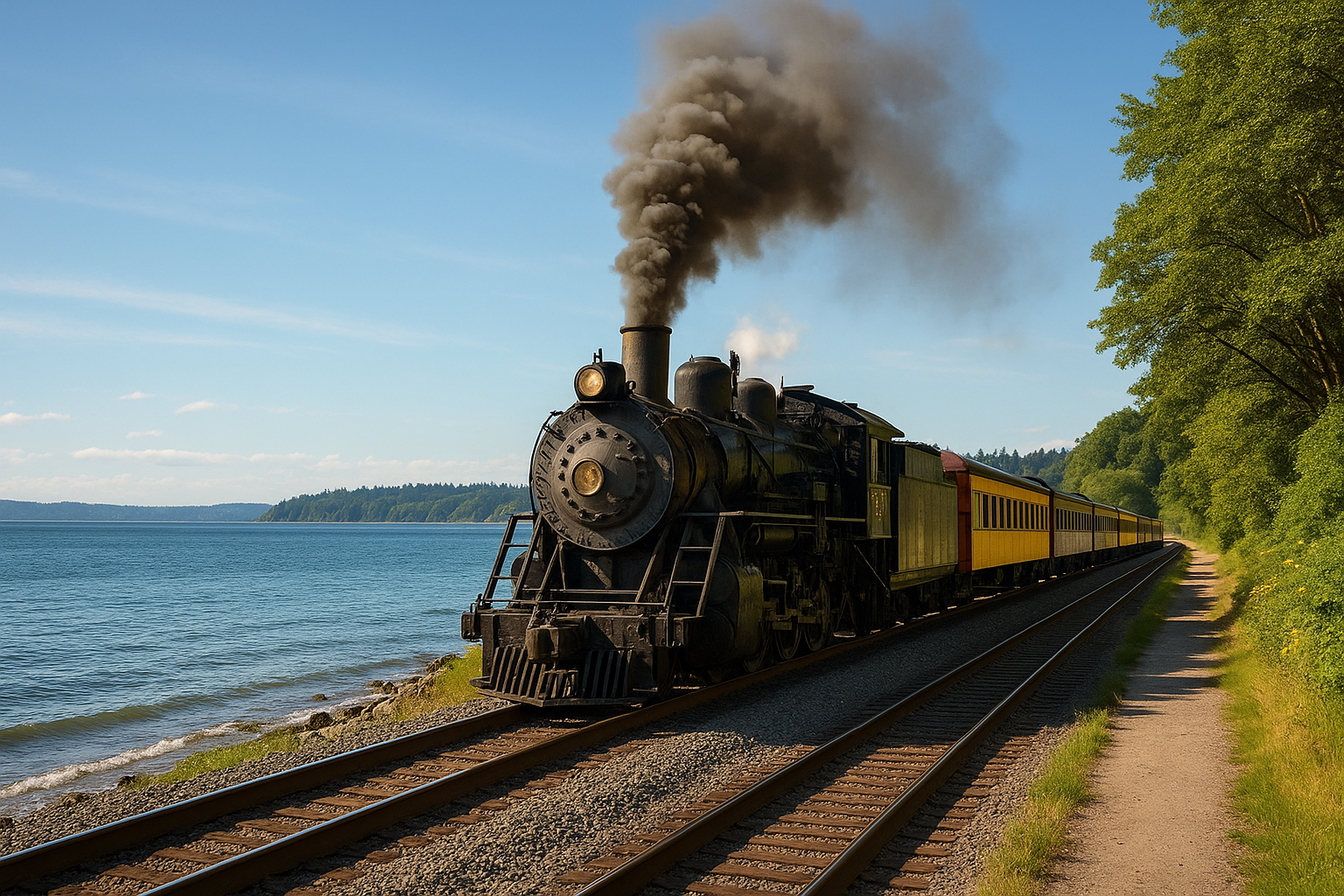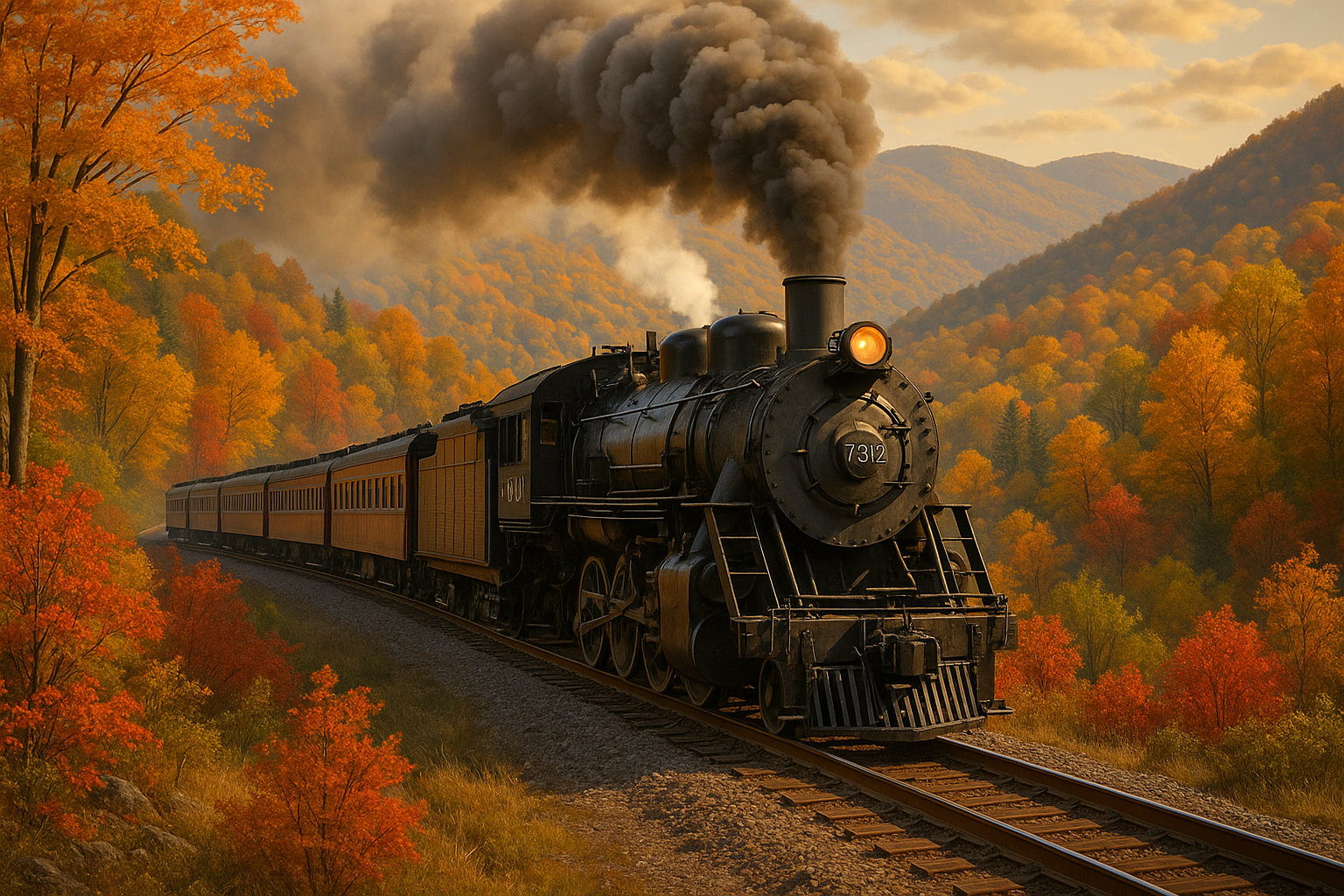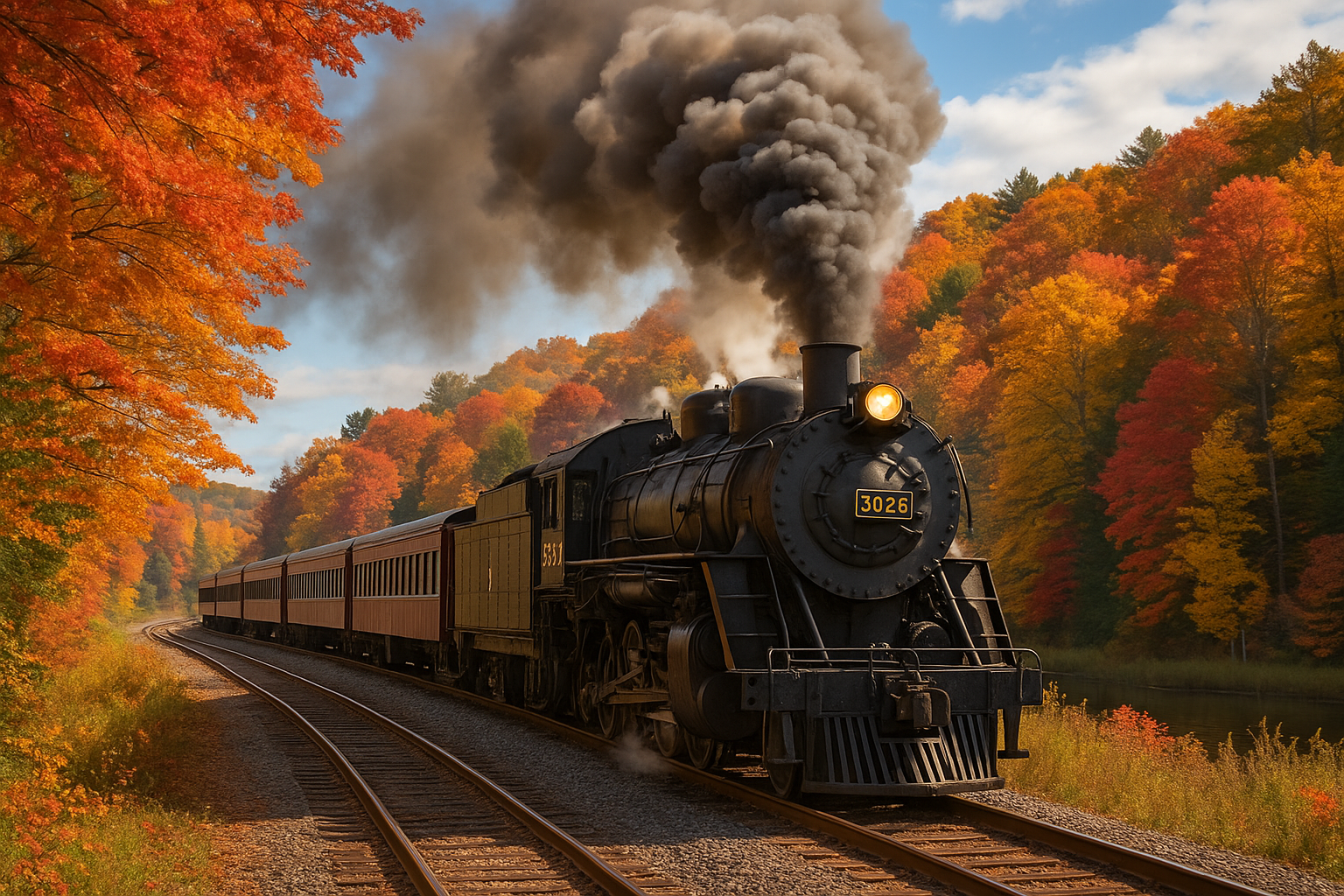Denver, South Park, and Pacific Railroad: "The South Park Line"
Last revised: September 10, 2024
By: Adam Burns
The Denver, South Park, and Pacific Railroad (DSP&P) was a historic 3-foot, narrow-gauge railroad that operated in Colorado during the late 19th century. Some its lines remained in use until World War II.
The railroad was created in 1872 and served Colorado's mining industry. It was known for its scenic routes through the Rocky Mountains.
Despite financial struggles and eventual bankruptcy, the DSP&P played a significant role in the early development of Colorado. Today, remnants of the railroad, including several restored stations and track segments, are popular tourist attractions.
History
The Denver South Park and Pacific Railroad (DSP&P), known colloquially as The South Park Line, is a remarkable chapter in the annals of railroad history. It grew into the second largest, 3-foot narrow-gauge system in the region behind only the Denver & Rio Grande.
In his book, "American Narrow Gauge Railroads," author Dr. George Hilton notes the railroad's genesis can be traced back to Governor John Evans who incorporated the Denver, South Park & Pacific Railway on October 2, 1872.
His efforts had originally began with the Denver, Georgetown & Utah Railroad incorporated earlier that year to handle the growing mining operations in the San Juan Mountains. In addition, he aimed to handle anthracite coal traffic near Gunnison, Colorado.
On June 16, 1873 the DSP&P was reincorporated as the Denver, South Park & Pacific Railroad with intentions of building a line from Denver, through South Park at which point it would follow the Arkansas River to Poncha Pass before reaching Del Norte along the Rio Grande River.
At A Glance
Denver - South Park - Como - Gunnison Como - Dillon - Climax - Leadville Como - Buena Vista - Alpine Tunnel - Gunnison | |
The railroad was then projected to reach the lucrative San Juan mining district in southwestern Colorado with a branch reaching Middle Park.
Interestingly, promoters had high hopes of the railroad eventually opening dual lines to the Pacific coast via Salt Lake City and the Grand Canyon.
Construction began in July, 1873 and the first segment, which later became the Morrison Branch, opened in June, 1874. This line provided the railroad with strong revenue from the Mt. Carbon Mine along with stone/aggregate tonnage and lumber traffic.
More than once during the DSP&P's construction the railroad was forced to find a different alignment due to competing narrow-gauge projects, notably the Colorado Central and, of course, the Denver & Rio Grande.
Evans had initially sought a line to Georgetown although the Colorado Central had already secured the only water-level alignment to the region, forcing the route through the South Park area instead.
By early 1879 the line had zigzagged its way south and west of Denver reaching Webster via the North Fork Canyon of the South Platte River.
Beyond Webster lay one of the railroad's most difficult stretches, Kenosha Pass. At a summit of 9,991 feet, this section required a 4% grade, descending from that point into South Park and Como. It opened in May, 1879.
The small junction of Como later became a major division point of the DSP&P as lines would eventually radiate north, south, and west from the town.
At first, promoters wanted to push rails directly south to the San Juan district but then eyed Leadville after mining took off in the area. However, the railroad had difficulty completing a line via Como due to the region's ruggedness.
Surveyors eventually found an alignment heading south to the Arkansas River, where a water-level grade then provided a direct, and easy, northward route into Leadville. Unfortunately, the DSP&P was now in the competing DR&G's territory and both were eyeing service to this mining community.
The South Park Line was completed to Buena Vista along the river on March 3, 1880, easily besting the D&RG which was still building from the south.
At this time, Gould, which then controlled the Union Pacific, became heavily involved with the D&RG's operations and was also aiming to acquire the Denver, South Park & Pacific. He had gained full control by November, 1880. In doing so, he understood that building dual lines into Leadville was superfluous.
As a result, both roads signed a Joint Operating Agreement on October 1, 1879 and built a joint line into Leadville in 1880.
The Leadville mining boom was a key motivator behind the DSP&P's expansion. It started around 1877 with the discovery of silver in the town, transforming an isolated mining camp into a bustling, prosperous city.
The boom created a massive demand for efficient transportation of ore and supplies, which the DSP&P sought to fulfill. However, the boom was short-lived, effectively ending by the mid-1890s due to falling silver prices following the passage of the Sherman Silver Purchase Act on July 14, 1890.
System Map (1910)
Under Gould's control the DSP&P forever lost its independence. Despite this, the narrow-gauge continued to grow and remained in operation for another half-century.
On January 1, 1881 it became part of Union Pacific and operated as its "South Park Division." Following completion of the joint line into Leadville, the DSP&P eyed a southwesterly extension into the San Juans at Gunnison to serve growing silver mines there.
The area also contained coal, limestone, and iron ore traffic. Unfortunately, the Rio Grande had already arrived here in 1881 thanks to its easier alignment over Marshall Pass via Salida.
The DSP&P's route was more direct at only 208 miles from Denver while the Rio Grande's was 290. However, the South Park's main line required much more difficult grades, often exceeding 4%, such as over Alpine Pass.
Alpine Tunnel
To reach Gunnison, engineers built the longest tunnel of any Colorado narrow-gauge, the famous Alpine Tunnel. It was located at an elevation of 11,612 feet, also making it the highest railroad tunnel in North America during its operation.
The tunnel was 1,805 feet in length and its tight interior clearances of 12'6" x 8'10" were the most constraining on the railroad. Even more challenging was the addition of a 24 degree curve from the western approach at Woodstock.
To make matters even more difficult the rock was loose and unstable, requiring the interior to be lined with redwood beams. The bore, as expected, proved extremely difficult to maintain, suffering two major cave-ins during operation.
After reaching Gunnison in September, 1882 the DSP&P continued northwestward along Ohio Creek to Baldwin where additional coal mines were located. Interestingly, promoters had intentions of continuing the route into Utah along the proposed extension to the Pacific coast.
The railroad built 4 miles beyond Baldwin and 8 miles of additional heavy grading. Alas, rival D&RG was already well on its way towards Utah by that time and controlled 75-80% of the total freight traffic out of Leadville. Similarly, it handled much of the San Juan mining business.
As a result, the DSP&P's once strong profits, totaling about $720/day was in decline by the early 1880s. Realizing its rival was slipping behind, the Rio Grande ended the Joint Operating Agreement into Leadville in February, 1884.
The South Park Line was subsequently forced to build its own line. The railroad's directors decided on a route that would extend northward out of Como over Boreas Pass to Dillon before heading southward through Fremont Pass and Climax. Rails arrived in Leadville later in 1884.
Interestingly, the DSP&P's Denver-Leadville line was an incredible 125 miles shorter than the D&RG's. In spite of this the Rio Grande still commanded most of the freight tonnage and the South Park Line's profitability ended after 1883.
The Leadville route marked the DSP&P's high water mark. At its zenith the railroad was 340 miles in length with main lines from Denver to Leadville and Gunnison. In addition, there were numerous mining branches as those previously mentioned.
Decline
The road's first serious troubles began in 1887 when the Alpine Tunnel suffered its first notable cave in, which cutoff service from Gunnison.
In August, 1889 the Denver, South Park & Pacific was reorganized as the Denver, Leadville & Gunnison Railway (DL&G) but remained under Union Pacific ownership. In 1890 the DL&G was consolidated into the new Union Pacific, Denver & Gulf Railroad, which included all of UP's properties in Colorado.
Following the financial Panic of 1893 the UP itself was forced into bankruptcy on October 13th that year. As a result, UP lost control of the South Park Line and the property entered receivership on August 7, 1894.
Under the direction of receiver Frank Trumball, the Alpine Tunnel was reopened in the summer of 1895.
Following UP's fallout, the Colorado & Southern Railway was officially incorporated on December 19, 1898 to acquire the former standard-gauge lines from Orin Junction, Wyoming to Dallas/Fort Worth and other Texas points.
It also took over the UP's former narrow-gauge properties in Colorado.
On January, 1899 the C&S acquired the former South Park Line and Colorado Central, operating them as a single system. The South Park's last notable addition occurred in 1900 when it picked up the 2.3-mile Mineral Belt Railway, which served mines in the Leadville area.
Abandonment
The decline of the DSP&P stemmed primarily from the end of the Leadville mining boom. As mineral extraction dwindled, the need for transportation services diminished, severely affecting the railroad's prosperity.
Fluctuating silver prices and the Panic of 1893 accelerated this downturn. After 1908 the C&S became a subsidiary of the much larger Chicago, Burlington & Quincy. The burgeoning CB&Q had little interest in narrow-gauge operations and slowly abandoned the former South Park Line.
The Gunnison line forever closed as a through route in 1910 when two major events occurred;
- Firstly, the Alpine Tunnel suffered another cave in and management had no interest in funding repairs. In October of that year the line between Hancock and Quartz (14 miles) was formally abandoned.
- Secondly, flooding along Trout Creek Pass closed more of the line between Garos and Buena Vista. Its abandonment left an isolated segment between St. Elmo and Hancock, accessed via Rio Grande trackage rights from Leadville to serve mines in the area. When the D&RG removed the third-rail on its Leadville line the section was abandoned on October 11, 1924.
Most of the remaining line west of the tunnel was turned over to the Rio Grande, some of which continued to be utilized while other sections, notably the Parlin-Gunnison segment, were deemed redundant and immediately abandoned.
Interestingly, the disconnected Baldwin Branch remained under Colorado & Southern ownership until 1937 when it was sold to the Rio Grande and remained in operation until 1954.
The Pitkin Branch was abandoned in 1937. By 1910 the only remaining segments of the original South Park Line still in service included the original main line from Denver - Leadville along with branches to Alma, Fairplay, and a few other short spurs.
Unfortunately, this remaining network was unsustainable from a profitability standpoint; the railroad was losing $160,000 annually, which after fixed charges totaled $250,000.
Naturally, it wasn't long before C&S management aimed to completely abandon the remaining system. After 1910 it closed the line over Boreas Pass between Como and Breckenridge, which cutoff service to Leadville. However, it was forced to reopen the line when a lawsuit was brought by the Breckenridge Chamber of Commerce.
In October, 1915 the C&S first requested complete abandonment but was denied by the Interstate Commerce Commission. However, 19.14 miles of the main line were eventually abandoned between Waterton and Buffalo when three dams were to be built along the South Platte River.
A new line to bypass the flooding, totaling nearly 17 miles and 16 tunnels, was projected to cost $2.9 million, funds the railroad did not have. Despite a second effort to abandon the property in 1928, the ICC again denied the request.
When the Great Depression hit, proposals were taken to sell the entire property to new operators. While a few were taken, neither were accepted. The C&S again renewed its abandonment application on August 16, 1935, requesting to end service over the entire property except for the Climax-Leadville segment which the railroad retained to serve a molybdenum mine.
This time the application was accepted; effective December 11, 1936 the property, including branches - sans the Climax-Leadville section - was approved for abandonment.
This decision was delayed following local protest to continue transportation service for the winter season, and trains continued running until April 9th and 10th, 1937.
Interestingly, the C&S wound up retaining the Denver-Waterton main line, as well as the branch to Silica, to continue serving feldspar mines.
The narrow-gauge operation continued until August 25, 1943, when, amid much fanfare, the last section of three-foot operation over the historic Denver, South Park & Pacific Railroad ended.
Legacy
Remarkably, fragments of the DSP&P railroad still remain today as a testament to its past glory.
Most notably is the remaining section east of Leadville, which was sold by then-Burlington Northern to a local group that launched tourist trains as the Leadville, Colorado & Southern.
It is still an attraction today, although now known as the Leadville Railroad, with trains departing from the historic depot in Leadville.
Some sections have been converted into recreational trails while others house historic landmarks, including the Boreas Pass and the Como roundhouse.
Of note here is the Denver, South Park & Pacific Historical Society which has rebuilt a section of trackage in Como, restored the roundhouse and depot, and plans to eventually operate trains over a short segment of track.
However, a significant portion of the original 335-mile track, including the Alpine Tunnel, has been largely consumed by nature and time.
The Denver South Park and Pacific Railroad represents more than just an enterprise; it embodies an era where the spirit of innovation prevailed over challenging terrain and economic hardships.
The once vibrant "Colorado and Southern Railroad" echoes the transformation of raw wilderness into a network of efficient logistics, indispensable during the "Leadville mining boom".
The remnants of DSP&P, though silent and still, continue to whisper tales of the past, inspiring us all about the power of human ingenuity. Through adversity and change, the legacy of the Denver South Park and Pacific Railroad continues to impact Colorado's landscape and history.
Sources
- Ferrell, Mallory Hope. Silver San Juan, The Rio Grande Southern Railroad (First Edition). Boulder: Pruett Publishing Company, 1973.
- Griffin, James R. Rio Grande Railroad. St. Paul: Voyageur Press, 2003.
- Hilton, George. American Narrow Gauge Railroads. Stanford: Stanford University Press, 1990.
- Overton, Richard. Burlington Route: A History Of The Burlington Lines. New York: Alfred A Knopf, Inc. 1965.
- Schafer, Mike. Classic American Railroads. Osceola: MBI Publishing, 1996.
Recent Articles
-
Washington's Whiskey Train Rides
Jul 10, 25 03:06 PM
Climb aboard the Mt. Rainier Scenic Railroad for a whiskey tasting adventure by train! -
Maryland's Whiskey Train Rides
Jul 10, 25 01:05 PM
You can enjoy whiskey tasting by train at just one location in Maryland, the popular Western Maryland Scenic Railroad based in Cumberland. -
Connecticut's Whiskey Train Rides
Jul 10, 25 11:03 AM
In this article, we'll take a closer look at these special train rides, explore the magic behind them, and offer tips for anyone looking to embark on this memorable journey.



